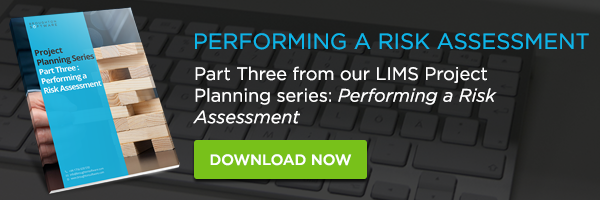Have you ever taken on a project that is large and overwhelming that you didn’t know where to start? It can feel like everything is blurry, and you’re looking for your glasses to bring your sight into focus. Deploying a LIMS can often feel like this, and risk assessments can help you bring the project to focus.
Risk Assessments are a good project tool because they challenge you to think of all the potential failures of the system and related processes. It also encourages you to consider the probability of the failure occurring, what impact that failure might have, and how you would deal with that failure if it did occur. Whether you discuss these concerns in a five-minute conversation or you chose to create a 20-page detailed document, you will consider these factors when deploying a LIMS.
Identifying Risks
Implementing a LIMS may have different meanings to different laboratories. For example, some laboratories may not have a significant impact on product quality, customer safety or satisfaction, and therefore, they feel the need to reduce deployment activities to system set-up and training only. Other laboratories may be subject to regulatory inspections and require a through deployment and validation process to maintain compliance. Identifying the risks or potential failures of your LIMS can help dictate the level of activities completed during your deployment.
When identifying risks, the best place to start is the process. What is the current process, and what is the new process post-implementation? For each step of the process, what are the potential failures that could occur? These failures could range from power outage, resulting in loss of system access to incorrect product specifications, resulting in the release of a faulty batch.
Assessing Risks
The purpose of identifying risks is to allow the laboratory to implement processes which minimise the risk occurring and consider business continuity procedures. To adequately assess each risk, detail the consequence or impact that the failure would have. In addition, you should as a minimum consider the probability of that risk occurring. These two factors, impact and probability, together create a risk score. You may find that a risk score is so low, that you may accept the risk without implementing any mitigating actions.
Determining Project Deliverables
After you have assessed your risks, you can then determine the best mitigating actions to implement. These actions could introduce new procedures or training plans. You may also find that your chosen LIMS has system controls to help mitigate these risks which would be in the form of system or static data configuration. Where you have identified that system controls lower or mitigate risks, this is the focus of your project deliverables. For those laboratories who chose a more rigorous LIMS deployment to meet regulatory requirements, these are critical areas which require validation and user acceptance testing.
Maintaining Risks
It’s important to understand that a risk assessment is only as good as the effort you put into it. If you choose to formalise and document your risks, it shouldn’t be a one-off exercise. Over time, factors will change. Whether it’s new technology, new employees, or simply more data stored on the system, your risks will naturally change over the lifetime of your LIMS. Therefore, reviewing risks when you make a change to your system or completing this exercise on an annual basis are both good practices. Maintaining your LIMS post-deployment ensures that the system continually addresses the evolving needs of your laboratory.







